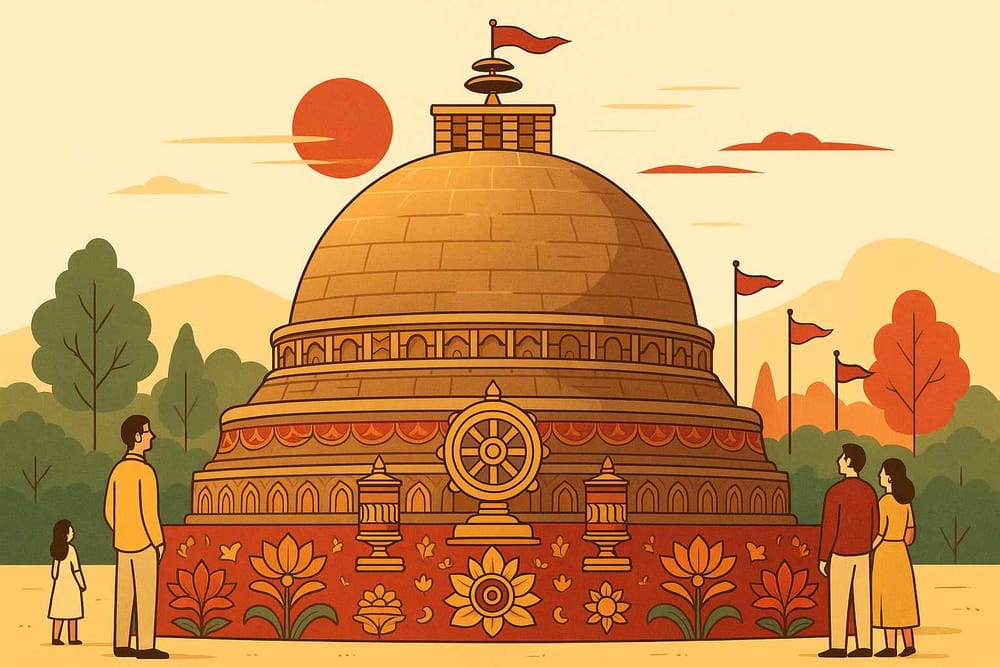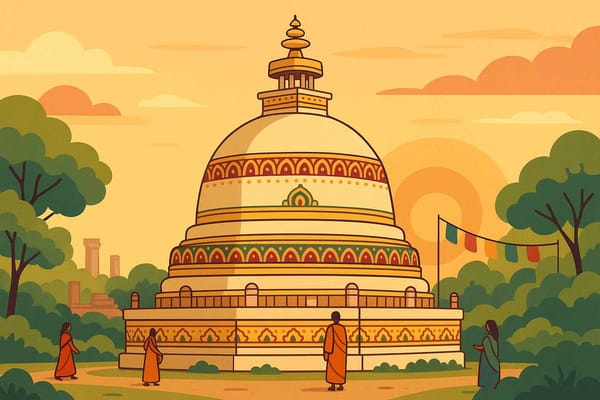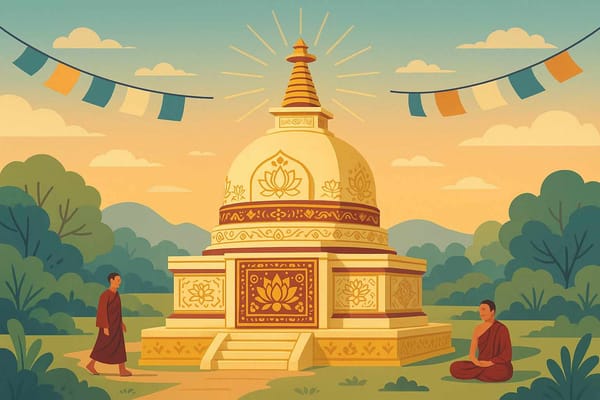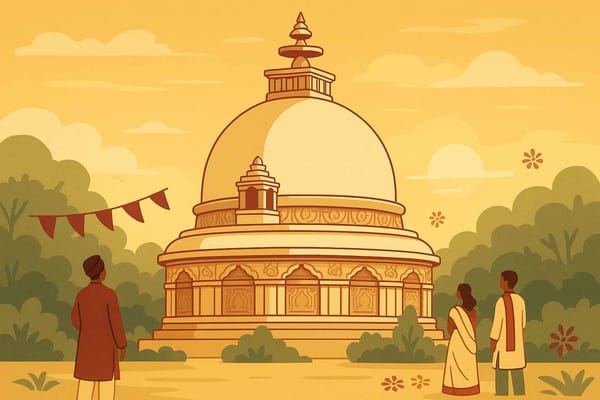
Dharmarajika Stupa: Journey Through History
Have you ever stood in a place so ancient that you can almost hear the whispers of history in the wind? A place where the stones themselves seem to tell stories of emperors, monks, and seekers from centuries ago. One such place is the magnificent Dharmarajika Stupa, nestled near Taxila in Pakistan. This isn't just a monument of brick and stone; it’s a living testament to a time when faith moved mountains and changed the hearts of kings. It’s a journey back to the 3rd century BCE, to the era of the great Mauryan Emperor Ashoka, and to the very roots of our shared Buddhist heritage.
The Great Emperor's Promise in Stone
The story of the Dharmarajika Stupa is deeply intertwined with the personal journey of Emperor Ashoka. After the heart-wrenching Kalinga War, Ashoka underwent a profound transformation—a true *hriday parivartan*. He turned from conquest to compassion and dedicated his life to spreading the peaceful teachings of the Buddha. The Dharmarajika Stupa was not just an imperial project; it was a promise, a *sankalp*, to enshrine the sacred relics of the Buddha and create a beacon of Dharma for the world.
Taxila, being a vibrant crossroads of ancient trade routes, was the perfect location. It was a melting pot of cultures and ideas, a true *gyan ka sangam* (confluence of knowledge). By placing this sacred stupa here, Ashoka ensured that the message of Buddhism would travel far and wide, carried by merchants, scholars, and pilgrims. Much like the great rulers of Mewar shaped the spiritual landscape of their kingdom, as we see in the historical sites of Udaipur, Emperor Ashoka imprinted the path of Dharma onto the very soil of the Gandhara region.
An Architectural Wonder with a Soul
At first glance, the Dharmarajika Stupa inspires awe with its sheer scale, but its true beauty lies in its spiritual design. Every element was crafted with deep meaning, turning the structure into a guide for meditation and reflection.
- The Majestic Dome and the Sacred Harmika: The massive, hemispherical dome represents the vast, boundless sky, symbolising the infinite nature of the Dharma. At its peak sits the *harmika*, a square railing that represents the sacred abode of the gods, a point where heaven and earth connect, guarding the precious relics enshrined within.
- The Path of Reflection (Pradakshina Path): Encircling the great dome is a wide path. This is the *pradakshina path*, where devotees would perform ritual circumambulation. Walking around the stupa in a clockwise direction was, and still is, a form of meditation—a physical act of centering oneself and honouring the divine.
- Gandhara Art – A Beautiful Sangam of Cultures: The stupa and the surrounding chapels are adorned with carvings that showcase the unique Gandhara style of art. This beautiful fusion of Greco-Roman and Indian aesthetics tells vivid stories from the Buddha’s life and the Jataka tales, making complex teachings accessible to everyone through the universal language of art.
A Sacred Heart for Pilgrims and Seekers
For early Buddhists, the Dharmarajika Stupa was one of the most important pilgrimage destinations. Why? Because it was believed to house the actual corporeal relics of the Buddha. Imagine the devotion and emotion of a pilgrim who had travelled hundreds of miles on foot to finally stand in the presence of such profound spiritual energy. It was a place for prayer, meditation, and learning, where the teachings of compassion and non-violence resonated deeply.
This stupa played a pivotal role in the journey of Buddhism from a regional faith to a world religion, inspiring art and architecture across Asia. While not all of us can make the physical journey to these ancient sites today, the desire to connect with our spiritual roots remains strong. At Bhaktilipi, we strive to be that bridge, bringing you timeless devotional stories and the essence of our traditions. Explore our collection on the Bhaktilipi platform and embark on your own spiritual journey from the comfort of your home.
Rediscovering a Lost Chapter of Our Past
For centuries, the grandeur of Taxila lay buried, its stories waiting to be rediscovered. It was in the early 20th century that archaeologist Sir John Marshall and his team began excavations, slowly unveiling this lost chapter of our history. The unearthing of the Dharmarajika Stupa was a monumental event. One of the most profound discoveries was a silver casket containing bone fragments, confirming the ancient belief that this stupa was indeed a reliquary for the Buddha's remains. This discovery wasn’t just an archaeological find; it was a validation of centuries of faith and oral tradition.
Today, as a UNESCO World Heritage Site, the Dharmarajika Stupa stands as a reminder of our shared heritage. It is accessible to visitors, historians, and spiritual seekers who come to witness its serene grandeur. A visit here is more than just sightseeing; it’s an opportunity to connect with a timeless legacy of peace and introspection.
The Enduring Message of Dharmarajika
So, what makes the Dharmarajika Stupa so unique and special? It is its direct connection to Emperor Ashoka’s mission and its sacred status as one of the original stupas built to house the Buddha’s relics. It is more than an ancient structure; it is a bridge to our past and a symbol of universal values. In a world that often feels divided, the quiet dignity of the stupa reminds us of the power of faith and compassion to unite humanity, transcending borders, cultures, and time itself. It is a piece of history that continues to inspire awe and reverence, a sacred echo that still calls out to the seeking soul.
A passionate group of people dedicated to preserving India's knowledge of Dharma, Karma, and Bhakti for ourselves and the world 🙏.
Comments
Related in

Exploring the Ancient Dharmarajika Stupa- History Unfolds
Imagine a place where the very air seems to hold the echoes of ancient chants, a place where stones, weathered by centuries, tell a story of unwavering faith. This isn't just a fantasy; it's the living legacy of the Dharmarajika Stupa in Taxila, Pakistan. This isn&

Dharmarajika Stupa- History Reveals Significance
Some places in the world don't just exist in the present; they carry the whispers of centuries within their very stones. Imagine standing on ground that witnessed a great emperor's change of heart, a place where the message of peace was shaped into a magnificent structure.

Dharmarajika Stupa- History's Journey Explores Mysteries
Have you ever felt the pull of a place you’ve never visited? A place where history isn't just in books, but whispers from the very stones themselves. For me, the Dharmarajika Stupa in Taxila, now in Pakistan, is one such place. It’s a silent witness to
